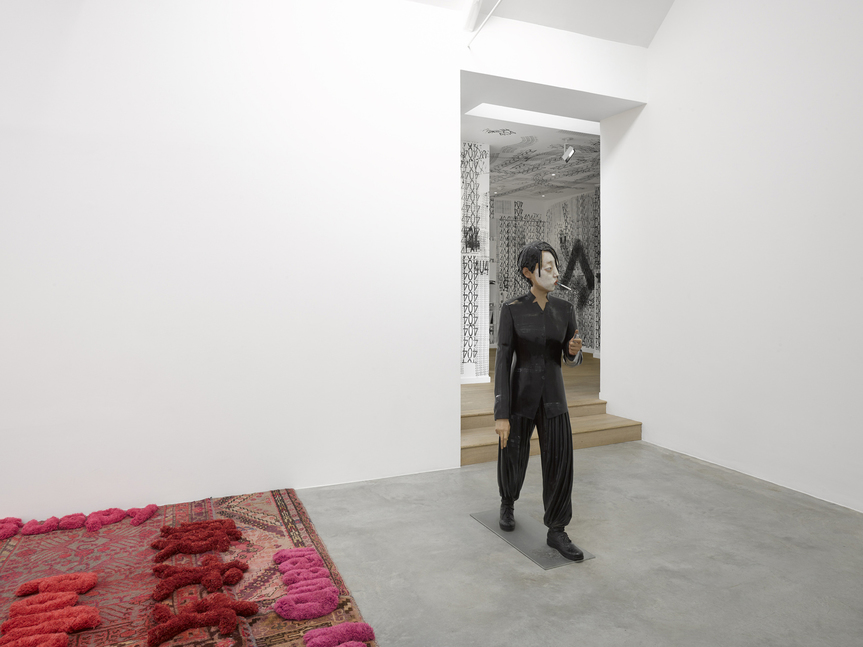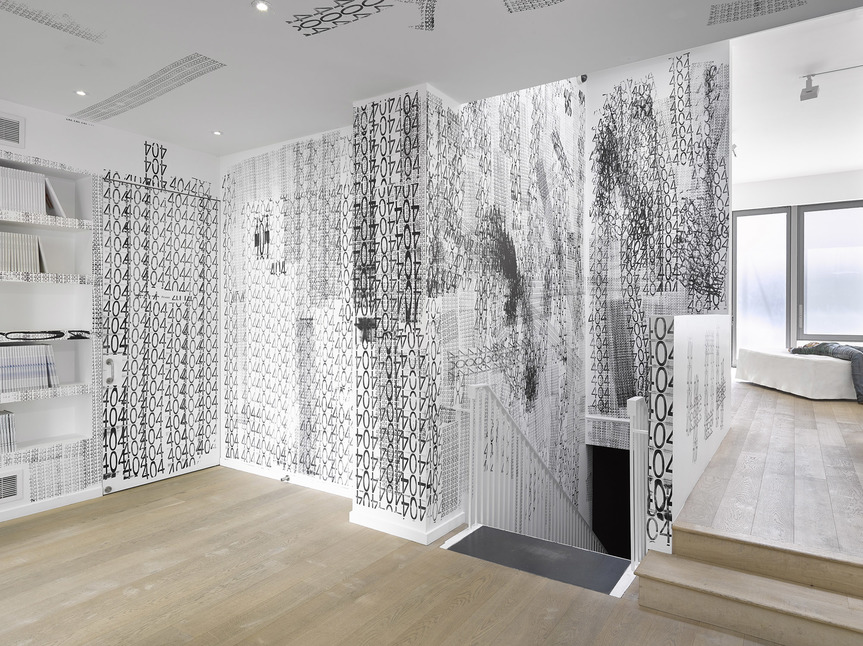-
From Current Issue
-
- Editor’s Letter Fire in the Heart
- Reviews I Gusti Ayu Kadek Murniasih
- Reviews 11th Seoul Mediacity Biennale: “One Escape at a Time”
- Dispatch Networked China
- One on One Monira Al Qadiri on Yukio Mishima
- Essays The rise of independent art spaces in pandemic-era Shanghai
- Features Tuan Andrew Nguyen
- Table of Contents
- Web Exclusives
- Archive
- Subscribe

R
E
V N
E
X
T
Installation view of (foreground) LIN TIANMIAO’s Producing Patterns, 2014, carpets in variable sizes, 9.4 × 13.43 m; and (background) Interconnectedness – 2#, 2019, wire mesh and thread, 140 × 210 cm, at “Afterimage: Dangdai Yishu,” Lisson Gallery, London, 2019. Copyright the artist. All images courtesy Lisson Gallery, London / New York / Shanghai.
In “Afterimage: Dangdai Yishu,” presented by London’s Lisson Gallery, curator Victor Wang sought to offer alternative interpretations for the development and genealogy of dangdai yishu (contemporary art) in China. Rather than focusing on contemporary Chinese output as derivatives of Euro-American artistic movements, comparing the creative histories of China and the West, or defining China’s contemporary art in terms of pre-modern and post-modern phases, Wang looks at the scene in terms of a figurative art tradition meeting with developments in art education and sweeping modernization to create a new post-figuration. From an art-historical perspective this is no doubt an important and noble endeavor. However, whether “Afterimage: Dangdai Yishu” succeeded as an exhibition in and of itself is another question.
Owing perhaps to the curatorial thesis, the aim of which is to deconstruct one set of potential commonalities in favor of a less established one, it was difficult to discern any strong visual coherence to the show, which for the most part left only the possibility of considering the works individually. There were some standout pieces, notable among them works from Yu Hong’s Witness to Growth series (2000– ), in which the artist pairs paintings documenting her own life with news photographs published in the same year. Ten years old on the playground in Beijing University of Aeronautics and Astronautics 1976 (2000), Nineteen years old in Beijing suburb 1985 (2000), and Twenty-six years old A photo showing a scene in the film “The Days” 1992 (2001), featuring the titular subjects, respectively display impressive control of light, movement and understated coloring, and all benefit from their contextualization by way of their pairings with other images. It’s worth noting, however, that these are the oldest works in the show, and decidedly figurative.
Among the show’s other figurative highlights were two painted fiberglass sculptures by Xiang Jing—Whole Dark (2005) and Slipping, Ticktock Ticktock (2005). The former depicts a woman walking and lighting a cigarette, while in the latter, another woman lies on a bed with a phone in her hand. The central figures both stare out of these frozen moments at something unknown, indicating some complex relationship with the outside world.
As for genuinely non-figurative works, there was little of note. On the walls of a space intended to connect two rooms was aaajiao’s 404 (2017). For this installation, the artist allows the audience to use ink-stamp rollers—which are left leaning against the walls—to print the eponymous “404” however they like onto the surrounding surfaces. The number is a reference to the error message that appears on blocked websites in China. The chaos with which the numbers appeared in the Lisson space recalls an action, seemingly performed in a state of agitation. However, to learn that this action was performed by a local audience raises questions about the process: What is to be gained by turning this gesture over? What can we derive from this, other than the brute fact of the Great Firewall? There may be some didactic value here for a Euro-American audience, but that seems beside the show’s curatorial intentions.
Elsewhere, Lin Tianmiao’s Protruding Patterns (2014) comprises a series of carpets sprawling over a roughly ten-by-ten-meter swathe of gallery floor, from which fluffly words protrude in Simplified Chinese and English. Some of the terms are provocative, such as “bimbo,” “The Toxic Woman,” and “femme fatale,” while others, like “burger,” are not so easily explicable. Not unlike aaajiao’s 404, the piece lacked a substantive sense of commentary, particularly in the context of Lin’s consistent rejection of the idea that her choice of materials puts her in the same category as various feminist artists who have similarly chosen to work with and elevate textiles. Ironically, while this makes the work more difficult to classify in itself, the distinction lends credence to the work having been included under Wang’s curatorial thesis.
Ultimately, while Wang’s thesis may be reflective of developments on the ground in China, it raised certain challenges with regards to creating a show that is capable of standing on its own, while the localization of certain pieces such as 404 presented further issues. Despite some strong individual showings, “Afterimage: Dangdai Yishu” was an imperfect offering.
Ned Carter Miles is ArtAsiaPacific’s London desk editor.
“Afterimage: Dangdai Yishu” is on view at Lisson Gallery, London, until September 7, 2019.
To read more of ArtAsiaPacific’s articles, visit our Digital Library.

















